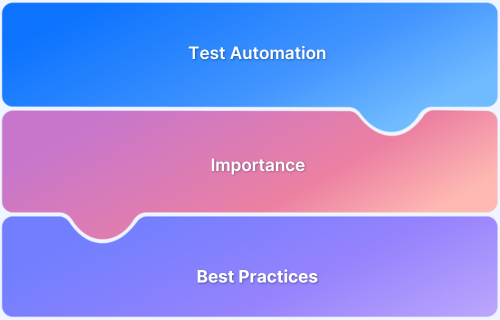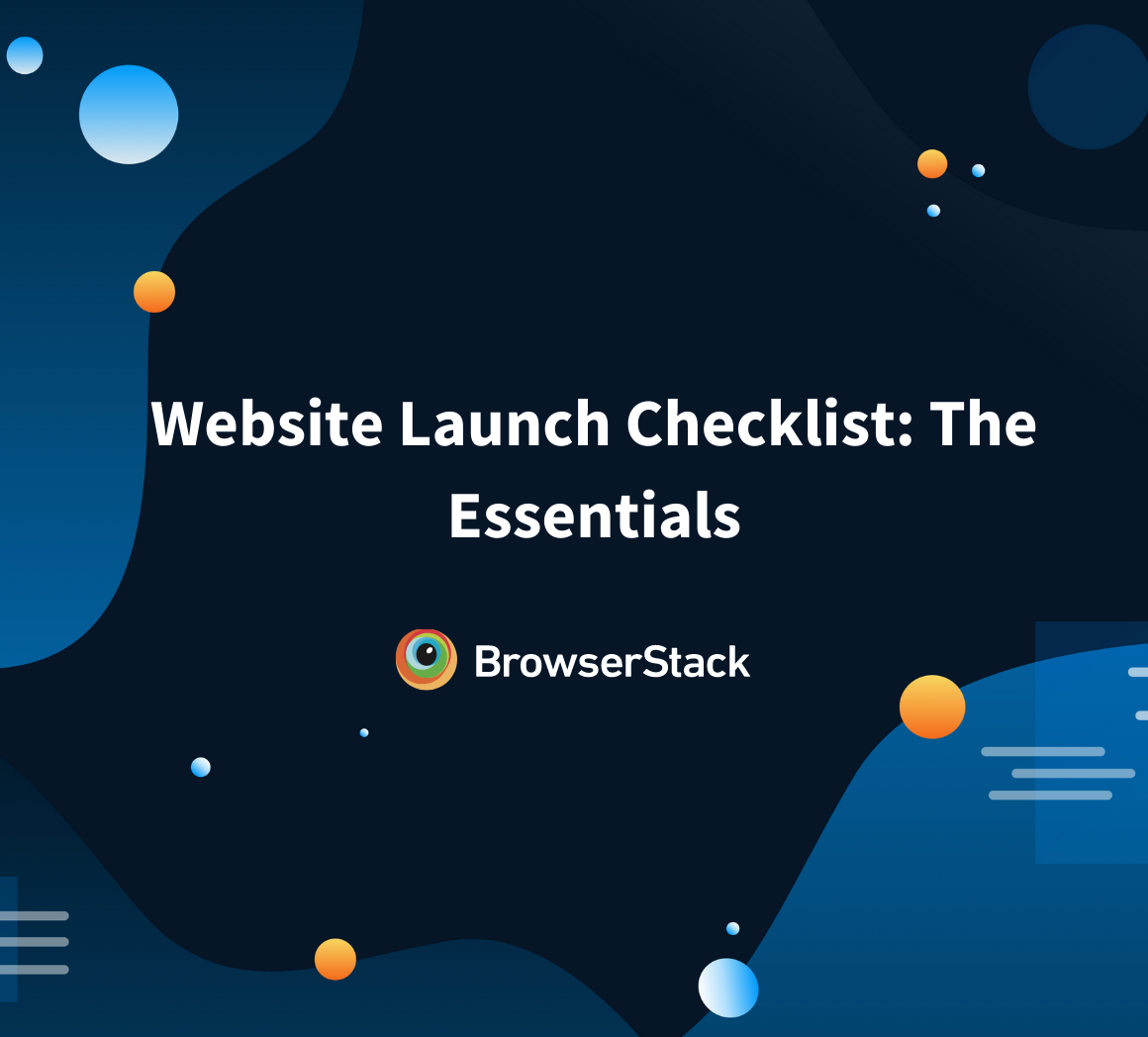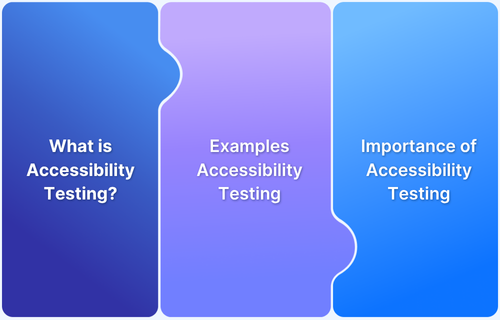A Complete Web Application Testing Checklist
By Shashank Nautiyal, Community Contributor - April 12, 2023
Most consumer decisions rely on the information found online, making websites a crucial channel for businesses to attract and engage users. However, simply having a website is not enough. It must be functional, user-friendly, secure, and performant. Web application testing ensures that sites meet these standards and provide a reliable experience to all users.
Overview
What is Web Application Testing?
- Standard software testing process to validate website functionality, performance, security, and usability before release.
- Ensures:
- Compatibility across browsers, devices, and OS
- Security and data integrity
- Optimal performance under load
- High usability for end-users
Why Web Application Testing Matters
- Reduces bugs and errors, improving reliability.
- Enhances user experience and engagement.
- Boosts SEO and brand credibility.
- Ensures consistent functionality across platforms.
- Supports inbound marketing and drives sales.
Website Testing Checklist
1. Functional Testing
- Validate all features work as intended.
- Test user inputs, forms, menus, and interactive elements.
- Focus on end-user perspective; include automated tests for efficiency.
2. Usability Testing
- Assess user-friendliness and navigation flow.
- Test with real users or personas to identify UX issues.
- Fix errors like broken links, typos, and confusing layouts.
3. Interface Testing
- Check communication between:
- Application and database
- Application and web server
- Ensure errors are properly handled and do not reach end-users.
4. Database Testing
- Validate query accuracy, data integrity, and performance.
- Ensure data is correctly created, updated, or deleted.
- Monitor response times under load.
5. Performance Testing
- Test speed, stability, and scalability under different conditions.
- Validate system can handle traffic spikes.
- Ensure fast response times for optimal user experience.
6. Compatibility Testing
- Test cross-browser, cross-device, and cross-platform functionality.
- Use real devices instead of emulators for accurate results.
- Ensure layout, buttons, text, and images render consistently.
7. Security Testing
- Prevent unauthorized access and data breaches.
- Test SSL, session management, and page access restrictions.
- Perform penetration tests and vulnerability scans.
This guide explains the importance of web application testing, key testing areas, and best practices to achieve high-quality, bug-free web apps.
What is Web Application Testing? Why is it so important?
Web application testing is a standard software testing practice to test websites and applications to identify potential bugs before it is accessible to web users. The issues like security, compatibility with multiple devices, performance, functionality, and ability to handle traffic and real-time users are tested.
Some of the factors that make Web App Testing significant during SDLC (Software Development Lifecycle) are:
- It nullifies or minimizes the bugs and errors on the website
- It increases website usability, hence its credibility
- It ensures visitors back frequently
- It improves ranking on the search engine rankings
- It draws more inbound links, thus increasing brand awareness and driving sales
- It ensures compatibility with different platforms & browsers
What to consider during web application testing: Checklist
When running web application tests, start with figuring out what the unique needs of the end-users might be. For example, the site should be optimized for:
- Interactive User Interface (UI): To ensure a better user experience and engagement, UI testing is a must.Read More: UI Testing Tools and Techniques
- Functionality: The website should be functionally streamlined and every element should function as expected.
- User-friendliness: A user-friendly website improves customer retention through better usability.
- Bug-Free: The website should function bug-free for more accurate functioning of different features, making it more reliable for the customers to use.
- Security: Amidst the increasing cyber-crimes and data breaches on the internet, keeping the user data secured is essential to build trust and credibility.
- Performance: Since the human attention span is lesser than a Goldfish, a web application should render fast enough to engage the user. Hence, it is essential to improve the performance of a website
- Cross browser compatibility: Users have different devices and browsers at their disposal, and to access the web content on the go, switching between multiple devices and browsers is common. Hence, a web application that works seamlessly across different browsers, devices, and OS serves the purpose of accessing web applications anywhere anytime.
Test Cross Browser Compatibility
Web Application Testing Checklist
To perform comprehensive web application testing, it is necessary to do different types of tests that fulfill the requirements mentioned in the web app testing checklist above. These different types of tests are described below.
1. Functional Testing
Functional Testing aims at testing the overall functional capabilities of the web app. In Functional Testing, all the features and operational behavior of a web app are tested to ensure the compatibility of features and specifications. It doesn’t have anything to test the internal mechanism and output specific to any input.
The functional testing intends to verify if your product has all the functional specifications as desired or mentioned in the development documentation. It ensures that the functionalities and requirements work from the end user’s perspective. It tests every minute possibility & input by a user that developers didn’t expect. The testing method should be completed with automated test cases to provide an effective positive user experience.
Read More: Functional Testing: A Detailed Guide
You can perform Functionality tests by following the below steps:
- Check the list of all the functional requirements
- Get a clear understanding of all the requirements through it
- Based on all the requirements, identify test input
- Based on the chosen test input values, compute the outcomes
- Execute all the test case
2. Usability Testing
Usability testing checks the user-friendliness of the elements in the web app. It tests the flow of the web app and how the user can navigate through it seamlessly. Usability testing relies on standard practices that ensure the ease of use and effectiveness of a web app. It roots out all the errors, like typos, punctuation, and weak flow. Together, these elements can make a poor impression of a website and reduce its capacity. Usability tests the application in the form that is accessed by the end-users. Hence, studying the user personas and their requirements is essential for usability tests.
You can perform Usability tests by following the below steps:
- Create a prototype or product ready to test
- Find the right users of testing
- Conduct a usability test
- Document all the tests
- Make a detailed analysis and repeat the process
3. Interface Testing
Interface Testing checks how the website communicates at different interfaces such as Application, Web Server, and the Database. It is different from Integration testing, where the different internal components of the application are put together and tested. In Interface testing, how the application communicates with the web server or the database is checked. During Interface testing, various interfaces are tested as follows:
- Application: Test requests are sent correctly to the Database, and the client-side output is displayed correctly. In this scenario, any error will be caught by the application. The error will not go to the end-user but to the administrator.
- Web Server: The web server is responsible for handling all application requests
- Database Server: It ensures that all the sent queries give desired outcomes to the Database.
Any web application has two major interfaces where the tests need to be performed:
- Between a web server and an application server
- Between the application server and the database server
Interface testing performed between any of the above interface is used to:
- Check whether servers are working perfectly in different scenarios
- Check if all faults are managed properly or any error pops out
- Examine all the results and check the link to a web server
4. Database Testing
Database testing is important to check how the web application stores data and performs various functions that include:
- Executing queries during testing if any error comes up
- Keep a regular check on the response time of queries
- Retrieved test data must be reflected accurately in the web application
- Any change when creating, updating, or deleting data in the database must not have data integrity
You can perform Database tests by following the below steps:
- Set up the test environment to test the software application.
- Execute the test by run a test cases under the test environment.
- Check the results and validate the output with the expected results.
5. Performance Testing
In Performance Testing, the test process relates to a system’s speed, stability, and scalability under different scenarios. It checks whether the system can deliver the same efficiency with various outputs from different users. Performance Testing ensures:
- The architecture can work with heavier load conditions.
- Fast response time with every new version of the software.
- Application can handle the maximum load and deliver optimal performance.
You can perform Performance tests by following the below steps:
- Identify the Test Environment and Tools
- Define Acceptable Performance Criteria
- Plan and Design Tests
- Prepare Test Environment and Tools
- Run the Performance Tests
- Resolve and Retest
6. Compatibility Testing
The same website renders differently in different browsers and their versions, which is why it is essential to perform cross browser compatibility tests. Cross Browser Testing allows you to test if your web application functions seamlessly and consistently across multiple browsers on different desktop and mobile devices. Every web element like buttons, images, text fields, lists, and more changes with the change in OS, which is why it is important to test cross-platform compatibility by testing on real devices as opposed to emulators or simulators.
BrowserStack’s real device cloud offers access to 3000+ real devices and browsers, and lets you test under real user conditions for better accuracy.
7. Security Testing
The process involves testing, analyzing, and reporting every security aspect of your app. Security administrators do it to test the security level of the app through both manual and automated security testing methods. Security testing performs different functions such as:
- It roots out unauthorized access to secure pages and puts an end to downloading authorized pages without approval.
- It kills automatic sessions after prolonged user inactivity
- It redirects website to encrypted SSL pages
You can perform Performance tests by following the below steps:
- Make a threat List and prepare test plan
- Create a traceability Matrix for every error and Vulnerability
- Choose the testing tools as per the requirement
- Prepare a test case document
- Execute Security Test Cases
| Testing Type | Action Needed | Status |
|---|---|---|
| Functional Testing | Check if the functional operation of the web app in different test scenarios is as expected | ✓ |
| Usability Testing | Identify different types of user personas and check if the website UI is user-friendly. | ✓ |
| Interface Testing | Check if different interfaces such as Application, Web Server, and the Database communicate as expected with each other. | ✓ |
| Database Testing | Check if the Data is flowing well within the Web App to and from the Database | ✓ |
| Performance Testing | Check if the Web App is able to bear the load of extra traffic without crashing and has a good loading speed | ✓ |
| Compatibility Testing | Check if the Web app is compatible with different device browser combinations working consistently | ✓ |
| Security Testing | Check if the web app is passing the penetration test ensuring security again data breach | ✓ |
Conclusion
To test web application comprehensively it is essential to follow the above checklist and perform different types of tests to ensure the web application is bug-free in every aspect. However, to identify the bottlenecks, it is important to test the applications under real user conditions, which is only possible by testing the web apps on a real device cloud.
By choosing a secured real device cloud like BrowserStack, QAs can efficiently test their web apps on 3000+ real browsers and devices. This makes testing Agile for them with wider coverage. The cloud allows parallel testing and supports integrations with popular CI/CD tools such as Jira, Jenkins, CircleCI, TeamCity, and Travis CI, to ensure streamlined Automation Testing of your web app.



